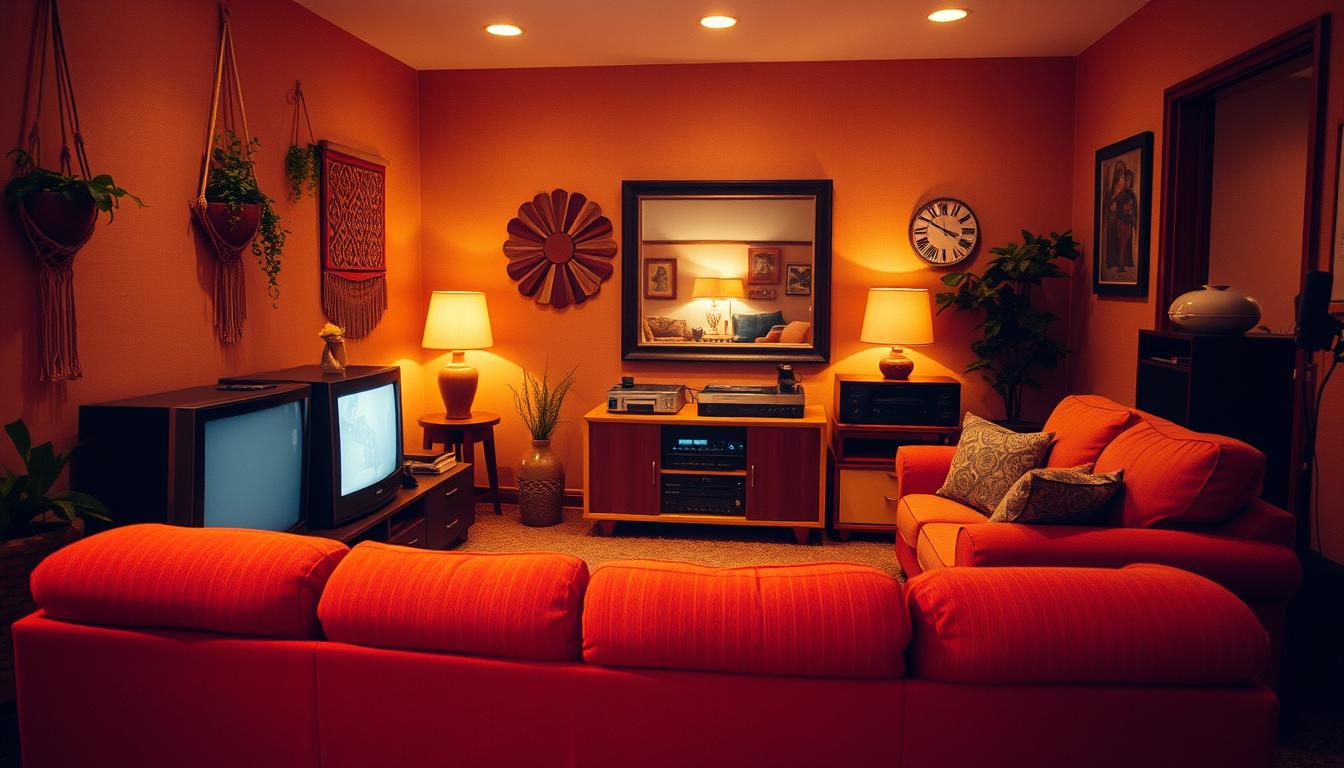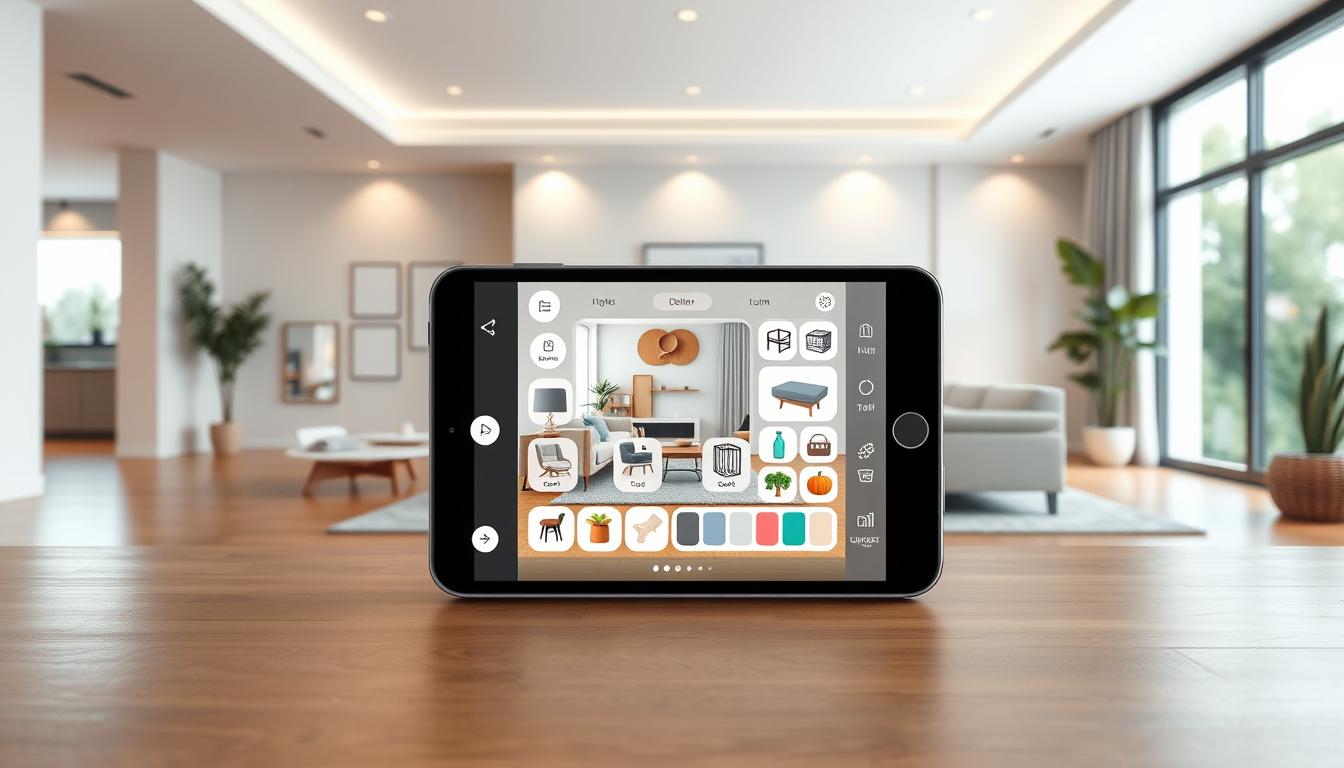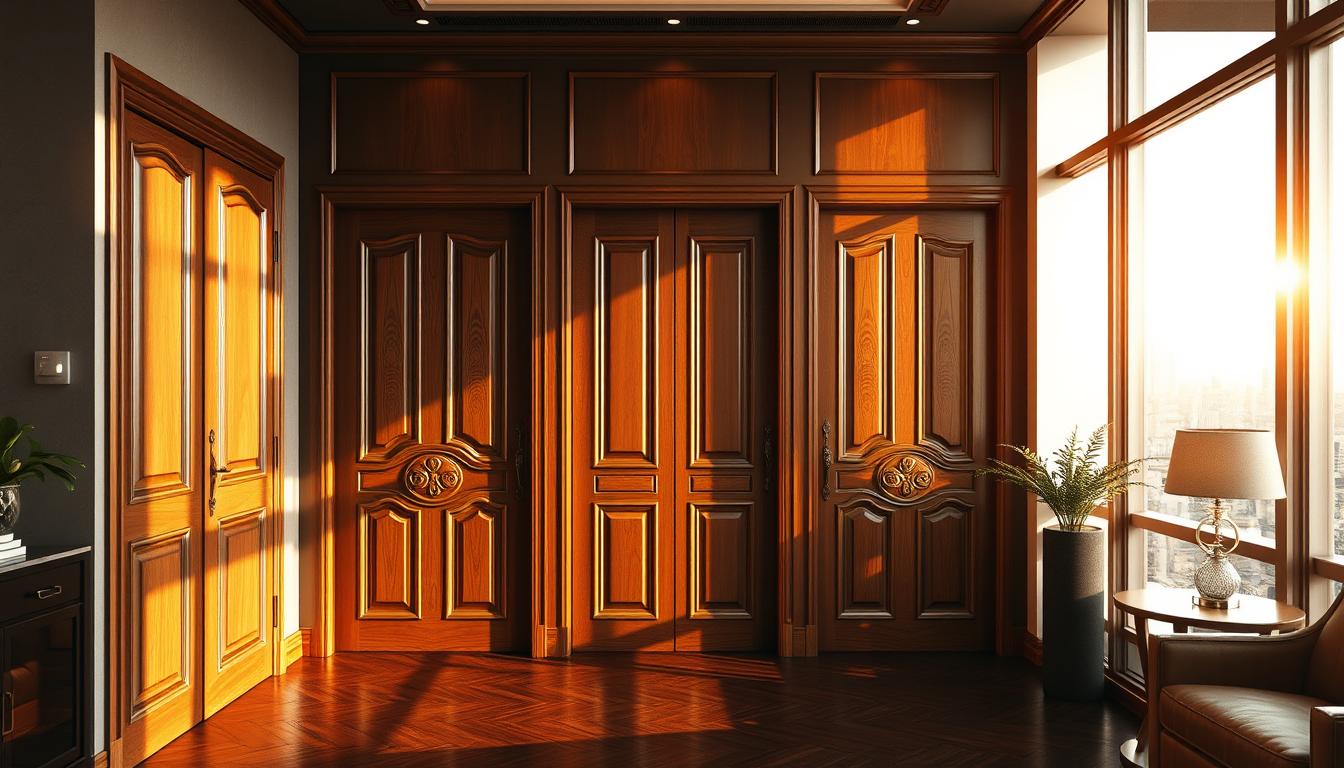The 1970s were known for bold retro home decor. Think shag carpeting, funky patterns, and bright colors. Today, over 60% of interior designers are adding vintage interior design touches to their work.
We’re diving back into the 1970s decor, finding ways to mix its iconic styles with today’s homes. By combining old charm with new flair, we can make unique and welcoming home interiors.
Key Takeaways
- Understand the core elements of 1970s interior design.
- Learn how to incorporate retro patterns and colors into modern decor.
- Discover tips for balancing vintage pieces with contemporary furniture.
- Explore the role of texture and lighting in retro-inspired spaces.
- Find out how to avoid nostalgia overload and maintain a modern aesthetic.
Understanding the 1970 Home Interior Aesthetic
Getting into the 1970s home style means adding mid-century modern touches, earthy colors, and bold designs. This era was all about mixing natural stuff, bright hues, and unique decor.
Key Characteristics of 1970s Design
The 1970s design focused on being comfy and useful. Furniture was low and curved, with simple lines and little decoration. This was a nod to mid-century modern style. Natural materials like wood, wicker, and rattan were big, adding warmth and texture.
Bold, bright colors and patterns were also big. Think shag rugs and patterned wallpapers. The 1970s were all about making a splash with color and texture.
Common Color Palettes
Colors were key in 1970s design. Earthy tones like avocado green, harvest gold, and burnt orange were common. They were often paired with neutral colors for a balanced look. These earthy tones were then highlighted with brighter, bolder colors for interest.
These color schemes didn’t just set the style; they also shaped the mood of homes. 1970s interiors were warm and welcoming, ideal for chilling out and hanging with friends.
Popular Textures and Materials
Textures and materials were vital in 1970s design. The era loved natural stuff, with wood, wicker, and rattan in furniture and decor. Shag carpeting was everywhere, adding a soft touch to rooms.
The 1970s also welcomed synthetic materials and new tech. Plastics, vinyl, and other synthetic stuff became common in furniture and decor. This opened up new ways to design and decorate homes.
Iconic Furniture Styles from the 1970s
The 1970s furniture was a mix of function and style. It was not just pretty but also showed the era’s cultural and social shifts.
The Rise of Modular Furniture
Modular furniture became a big deal in the 1970s. It let people change their rooms easily, fitting different needs and events. This flexibility was key to the era’s design, focusing on being useful and adaptable.
Modular furniture also made homes more creative and flexible. It helped people try out new layouts, making the 1970s known for its bold and changing home decor. Some key features of modular furniture include:
- Interchangeable components
- Multi-functional pieces
- Adaptable configurations
Influential Designers and Brands
The 1970s brought forward many influential designers and brands. Names like Charles Eames and Ettore Sottsass introduced new materials and styles. These became the era’s signature look. Some well-known brands from that time were:
- Eames Furniture
- Memphis Milano
- Bianchi International
These designers and brands were bold. They used bright colors, new materials, and shapes that looked like they came from the future.
How to Source Authentic Pieces
If you want real 1970s furniture, there are many places to look. You can check out vintage stores, online sites, and estate sales. When looking for vintage furniture, remember to:
- Check the condition well
- Learn about the designer or brand
- Make sure it’s the real deal
By following these steps, you can find unique, real pieces. They will bring a bit of the 1970s into your home, mixing old charm with today’s style.
Color Schemes to Embrace
The 1970s home interior was known for its color schemes. These blended earthy tones with vibrant accents.
The 1970s were all about expressing oneself through interior design. Color was a key part of this. The era’s love for nature showed in its earthy tones, making homes warm and welcoming.
Earthy Tones and Vibrant Accents
Earthy tones like terracotta, sienna, and moss green were big in 1970s design. These natural hues were mixed with bright colors like turquoise, orange, and yellow. This mix added depth and interest to rooms, making them cozy yet lively.
To bring this look home, pair earthy walls with bright furniture or accessories. For example, a terracotta sofa with turquoise pillows can capture the 1970s vibe.
The Use of Neutrals
Neutrals were key in 1970s design, balancing bold colors. Beige, cream, and taupe were used to soften bold hues and patterns. They were also in furniture and rugs, adding sophistication.
To use this in your home, start with neutral furniture and flooring. Then, add color with accessories and wall decor. This way, you can enjoy 1970s colors without feeling overwhelmed.
Bold Patterns and Wallpapers
The 1970s loved bold patterns and wallpapers. Geometric, floral, and abstract designs were popular, often in bold colors. These patterns were on wallpaper, upholstery, rugs, and bedding, adding fun and eclecticism to homes.
To add this retro charm to your home, try vintage or vintage-inspired wallpapers and fabrics. Even a single bold wall or patterned rug can make your space feel like the 1970s.
Flooring Options That Define the Era
The 1970s home interior featured a variety of flooring, from shag carpeting to unique tile designs. This variety helped shape the era’s style, making it a favorite among those who love retro home decor today.
The Popularity of Shag Carpeting
Shag carpeting was a big hit in the 1970s. Its deep piles and bright colors made rooms cozy and bold. It was loved for creating a warm, welcoming feel, becoming a common choice in many homes.
Hardwood and Laminate Styles
Hardwood and laminate flooring were also popular, offering a different look. Hardwood flooring, in particular, added timeless elegance to rooms. It came in many stains and finishes, fitting various decor styles.
Distinctive Tile Designs
Tile designs in the 1970s were unique and eye-catching. They ranged from geometric patterns to earthy tones. Tiles allowed for personal expression, letting homeowners show off their style through their floors.
| Flooring Type | Characteristics | Popularity in 1970s |
|---|---|---|
| Shag Carpeting | Deep piles, vibrant colors | High |
| Hardwood Flooring | Timeless elegance, various stains | Moderate |
| Tile Flooring | Geometric patterns, earthy tones | High |
In conclusion, the 1970s flooring was diverse and showed the era’s design spirit. By adding these retro touches to today’s homes, we honor the past while keeping our spaces stylish and unique.
Lighting Techniques Inspired by the 70s
Bringing the 1970s vibe into your home means using lighting that’s both retro and bright. The right lights can make a room feel warm and full of character, just like the mid-century modern style.
Iconic Lighting Fixtures of the Era
The 1970s were famous for their unique lighting that made rooms stand out. Some top picks include:
- Sputnik chandeliers, with their many arms and bulbs, for a bold look.
- Globe lights, for their simple yet elegant design.
- Lava lamps, for a psychedelic vibe.
Bringing in Natural Light
Letting in natural light was a big part of 1970s home design. Big windows and skylights were used to fill rooms with sunlight, making them feel bright and open. To get this look, try:
- Adding bigger windows or sliding glass doors.
- Installing skylights or solar tubes for light from above.
- Keeping window treatments simple to let in more sunlight.
Playing with Colorful Lamps
Colorful lamps were a fun way to make a room unique. With their bright colors and interesting shapes, these lamps became key pieces. To add this touch, consider:
- Picking lamps with bold, bright colors.
- Choosing lamps with unique shapes to add character.
- Using lamps as accent pieces to add color.
By using these lighting ideas, you can make your home feel warm and full of personality, blending the mid-century modern aesthetic with your own style.
Wall Art and Decor Essentials
To truly capture the essence of a 1970s home, one must consider the wall art and decor that defined the era. The 1970s were a time of great creativity and expression. This was reflected in the diverse and vibrant decorative elements used in homes.
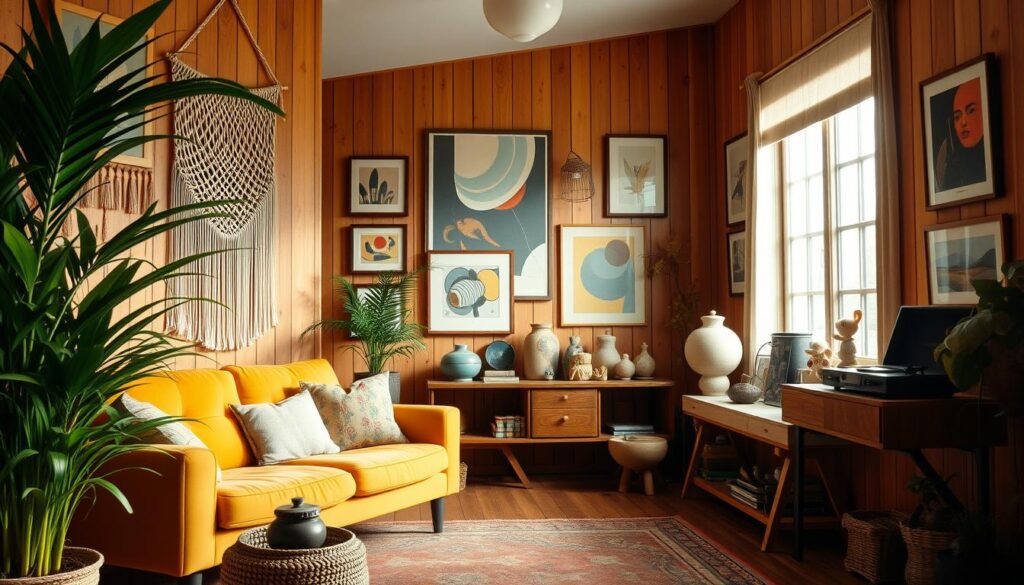
Iconic Posters and Prints
Posters and prints were a staple of 1970s decor. They often featured iconic imagery from the era, like movie posters and music concert flyers. These pieces added a personal touch and reflected the cultural and social zeitgeist of the time.
To incorporate this trend into your home, look for original or reproduction posters that resonate with your interests. Framing them in simple wooden frames or metal frames can enhance their retro appeal.
The Role of Macramé and Textiles
Macramé wall hangings and textiles played a significant role in 1970s interior design. They added texture and warmth to rooms. Macramé, with its intricate knotting techniques, was popular for creating plant holders and wall hangings.
Incorporating vintage or handmade macramé pieces, or even attempting your own macramé projects, can add an authentic touch. Using textiles like vintage scarves and tapestries as wall hangings can also enhance the retro aesthetic.
Featuring Vintage Accessories
Vintage accessories are key to achieving an authentic 1970s look. This can include vintage clocks, retro-themed wall art, and antique decorative items. The key is to strike a balance between vintage and modern elements to avoid overwhelming the space.
When selecting vintage accessories, consider items that reflect the era’s love for bold patterns and bright colors. Displaying these items thoughtfully, like grouping vintage plates on a wall or hanging a vintage mirror, can create focal points in your room.
Bringing Vintage Technology into Modern Spaces
Vintage technology is back, and we’re finding ways to mix it with today’s homes. The 1970s were a big time for tech, and adding these elements can make our homes stand out.
This trend isn’t just about looking back. It’s about adding character and usefulness to our homes. Let’s explore how retro appliances and old electronics can change our homes.
Retro Appliances: The Comeback
Retro appliances are a big part of this trend. Brands like Smeg and Big Chill are bringing back their classic looks with a modern twist. This makes them perfect for adding a 1970s vibe to your kitchen.
- Colorful Fridges: Bold colors and sleek designs are making a statement in modern kitchens.
- Retro Stoves: From gas to electric, retro stoves are being reimagined with vintage aesthetics.
- Vintage-Style Dishwashers: These appliances combine the charm of the past with modern efficiency.
Integrating Old-School Electronics
Old-school electronics, like vintage radios and record players, are more than just decorations. They can actually work. Vinyl records are coming back, making vintage record players a great addition to homes.
Here are some tips for adding old-school electronics:
- Restoration: Make sure vintage electronics work well by restoring them.
- Placement: Place vintage electronics in your home to make them stand out.
- Mix and Match: Mix vintage electronics with modern ones for a unique look.
Tips for Functional Décor Elements
When adding vintage technology, it’s key to balance looks and use. Here are some tips:
- Choose Functional Pieces: Pick vintage items that are both pretty and useful.
- Blend with Modern Elements: Mixing old and new tech creates a cool, eclectic space.
- Consider the Space: Make sure the vintage tech fits well with your decor and doesn’t clutter the space.
By carefully adding vintage technology to our homes, we can make a space that’s both unique and useful. It’s a way to honor the 1970s in our modern lives.
Tips for Mixing Old and New Elements
Mixing vintage charm with modern functionality is key to a unique 1970s-inspired home. We’ll explore how to blend old and new elements for a harmonious space.
Balancing Vintage with Contemporary Design
To balance vintage and modern, start by picking statement vintage items. Then, build a modern framework around them. For example, pair a vintage sofa with a modern coffee table for contrast.
Key considerations:
- Choose a few vintage pieces to anchor the room.
- Use modern furniture to complement and balance the vintage items.
- Keep a cohesive color palette to tie the room together.
Choosing Accent Pieces Wisely
Accent pieces are crucial for a retro look. Choose items that reflect the mid-century modern aesthetic. Think vintage posters, macramé wall hangings, or retro-patterned textiles.
| Accent Piece | Description | Effect |
|---|---|---|
| Vintage Posters | Retro advertisements or travel posters | Adds a nostalgic touch |
| Macramé Wall Hangings | Intricately knotted wall decorations | Brings texture and a handmade feel |
| Retro-Patterned Textiles | Fabrics with 1970s-inspired patterns | Enhances the retro aesthetic |
Maintaining Functionality in Design
While looks are important, function is just as crucial. We should ensure our design choices don’t sacrifice usability. Choose multi-functional furniture to balance aesthetics and function.
Tips for functional décor:
- Opt for storage ottomans or vintage trunks for storage.
- Choose furniture with clean lines and minimal clutter.
- Incorporate modern technology seamlessly into vintage décor.
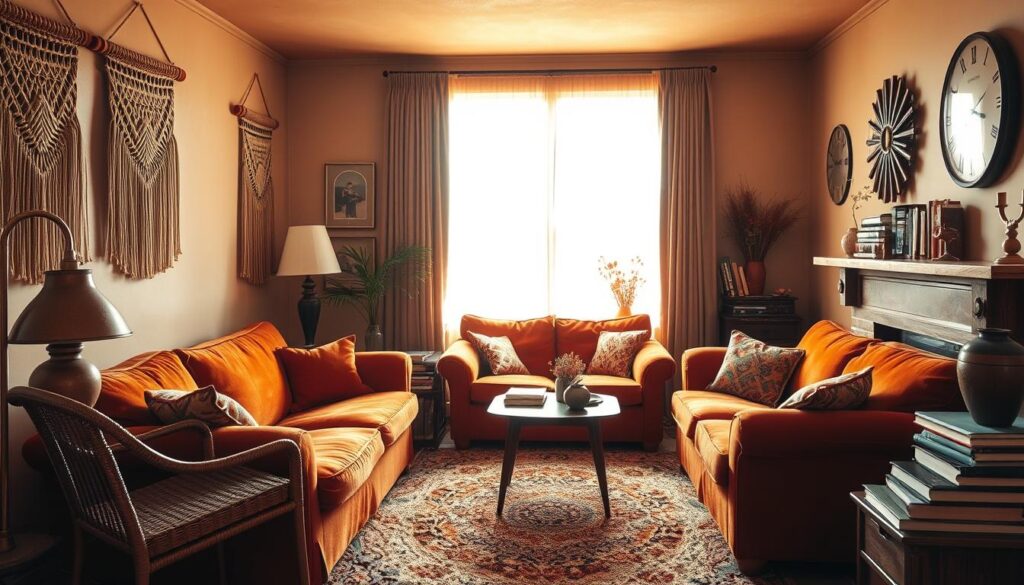
By mixing old and new elements thoughtfully, we can create a 1970s-inspired home. It should feel both nostalgic and modern. The key is finding a balance between vintage charm and modern functionality.
Outdoor Living Inspired by 1970s Trends
When we step outside, we can easily bring back the 1970s charm. The 1970s made outdoor living a big part of our homes. It was all about comfort, color, and connecting with nature.
Using Outdoor Fabrics and Furniture
To capture the 1970s outdoor vibe, focus on the right fabrics and furniture. Vibrant colors and bold patterns were key back then. We can still use these in our outdoor areas today.
- Look for outdoor furniture with bright, bold upholstery. It should reflect the 1970s’ fun and carefree spirit.
- Choose durable, weather-resistant fabrics that keep their color and texture even when it’s wet.
- Add natural materials like wicker and rattan. They bring warmth and texture to your outdoor space.
Creating a Relaxed Patio Space
A relaxed patio is all about feeling welcome and cozy. To make it happen, think about these tips:
- Put in comfy seating like plush sofas and big pillows in retro prints.
- Use ambient lighting, like string lights or lanterns, for a warm feel at night.
- Bring in plants and wood accents. They add warmth and texture to your patio.
The Impact of Landscaping Choices
Landscaping is key to our outdoor space’s look. In the 1970s, it was all about natural beauty and blending indoors and outdoors.
Some important landscaping choices include:
- Use native plants and flowers that are low-maintenance and attract local wildlife.
- Choose natural stone and wood for paths and hardscaping. They add texture and interest.
- Make a layered landscape with groundcovers, shrubs, and trees. It adds depth and dimension.
By using these elements, we can make outdoor spaces that honor the 1970s. They also offer a unique and welcoming place for relaxation and fun.
Final Thoughts on Achieving a 1970 Home Interior
Our journey through 1970s home interior design shows how vintage elements can make your space unique. By using the era’s iconic styles, colors, and textures, you can create a retro-chic atmosphere.
Personalizing Your Space
To make your 1970 home interior special, add your personal style. Mix vintage pieces with modern accents for a unique look. For example, pair a vintage sofa with a modern coffee table.
Add vintage patterned rugs to a room with sleek, modern furniture. This way, you can have both old and new in your space.
Finding Inspiration
For more inspiration, check out vintage home decor magazines. Visit antique stores or browse online on Etsy or eBay for 1970s decor. You can also look at designs from famous designers like Eames or Herman Miller.
Creating a Timeless Experience
To keep your 1970 home interior timeless, balance vintage with modern functionality. This way, your space will feel both retro and contemporary. With these tips, you’ll have a stylish and functional vintage interior design.

